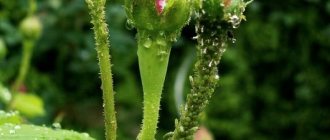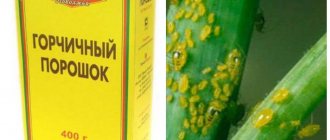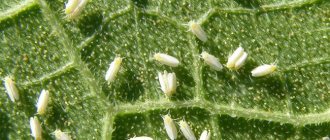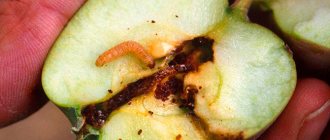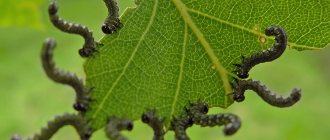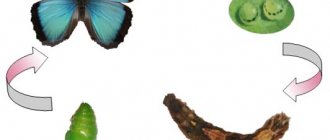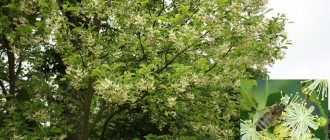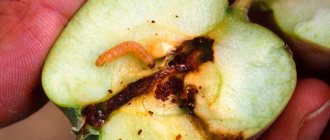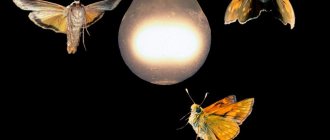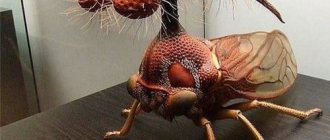Roses, rightfully considered the queens of any garden, can decorate any plot or flower bed. It is very annoying when, in the midst of fragrant flowering, they are subjected to a massive attack of pests.
Among the insects that attack rose bushes, green caterpillars are quite common. They not only spoil the decorative appearance of the plant, but can cause great harm and even cause the death of the plant. It is important to know how to combat these parasites and prevent their massive invasion.
Caterpillars can ruin the appearance of a rose
How to treat roses against caterpillars: professional products
The leaf roller lays eggs in the fall under the bark of trees, a layer of leaves, and old stumps. In early spring, larvae emerge from them - caterpillars with a green-brown color. There are about 200 eggs in one clutch, so the scale of infection of the flowerbed is quite significant.
Leaf roller larvae go through several stages of development, the entire maturation cycle lasts about 2 months. The threat of flower infection appears in early spring, with the peak of pest activity occurring in May-June. By mid-summer, the caterpillars pupate and after a while turn into butterflies.
There are different ways to control caterpillars in gardens. Broad-spectrum chemicals are commercially available that easily destroy larvae and resist re-infestation. It is recommended to spray roses against aphids and caterpillars in dry weather early in the morning or in the evening.
- Nitrophen. To get rid of caterpillars on roses at the initial stage of their infection, and to prevent significant damage to the plants, in early spring the crop is sprayed with a Nitrophen solution. The fungicide effectively destroys larvae at the initial stage of their development and protects the plant from repeated attack for about 60 days. One treatment is enough to ensure excellent flowering for the entire season. 300 ml of the drug is diluted in 10 liters of cold water. Roses should be sprayed using a watering can, spray bottle or spray bottle.
- Aktara. Broad-spectrum insecticide. You can get rid of caterpillars on roses in just one treatment. The systemic drug penetrates the leaf blade, the poison is not washed off by rain, and does not lose effectiveness at high temperatures. Poisonous properties are present for about 30 days. This is quite enough to save the entire flowerbed from aphids and caterpillars. Dilute the drug in warm water. For 10 liters of liquid, 8 g of the drug is required. It is allowed to re-treat roses against leaf roller after a month, if necessary.
- Actellik. Professional chemical product for exterminating garden and indoor pests. The plant can be sprayed during any growing season. To prevent infection, roses should be treated in May and early June. The toxic properties last for about a month. The maximum effect is observed during the first 2 hours, when pests receive a dose of poison by contact and die in a few minutes. Subsequently, caterpillars are poisoned during feeding. To prepare a solution, dissolve 2 ml of the drug in 2 liters of cold water.
You can fight green caterpillars on roses using biological agents. The active components gradually disrupt the life processes in the caterpillars’ bodies and kill them within 10 days. The plant must be sprayed twice a month while there is a threat of infection.
You can treat roses against aphids and caterpillars with such preparations as Intavir, Iskra bio, Fitoverm.
Folk remedies
If your rose is being eaten by caterpillars, you need to act quickly. A large colony of pests can destroy a flowerbed in a few months. You can treat roses against caterpillars with folk remedies at any time during the plant’s growing season.
- Mustard powder. Sprinkle the paths in the flowerbed, and also use mustard to prepare the solution. Add powder and a little laundry soap to the water. Spray the leaves. Properties last for several days in dry weather. If pests are detected again, repeat spraying every 3 days.
- Ash. The fight against black caterpillars on roses is not complete without wood ash. The same remedy saves flowers from aphids, leaf roller larvae and many other pests. Ash is sprinkled on the soil in the flower bed and watered abundantly. The active components penetrate the plant juice, making it bitter and unattractive to caterpillars. A solution with the addition of laundry soap and ash is sprayed onto the leaves. The product irritates the skin of the larvae, causing them to leave the plant.
- Sagebrush. The poisonous plant not only repels the larvae with a persistent odor, but also leads to death. 1 kg of wormwood is poured into 3 liters of water, boiled over low heat for 20 minutes. Let it brew for at least 2 hours. Spray the bush and water the soil.
You need to systematically fight caterpillars using folk remedies. If the flower bed is heavily infested, one time will not be enough. Folk control methods are the same for vegetables, shrubs and trees. The recipes for killing pests on cabbage, plums or roses are the same.
To reduce the number of larvae, they are collected by hand. They repel with a solution of table vinegar, ammonia, boric acid, tobacco, garlic tincture, ordinary soapy water with added salt, baking soda. You can get rid of pests with live plants by planting calendula, marigolds, and peppermint nearby.
Biological attack
Ants are one of the main causes of aphids. Black and red insects guard pests and carry them from one bush to another. To defeat the green bugs, you need to destroy the ants:
- Place pieces of double-sided tape or paper treated with non-drying glue around the rose bushes.
- Place bait with poison, for example, minced meat with brown or honey with boric acid.
- Treat ant trails with unrefined sunflower oil, elderberry or wormwood tincture. Scatter dry or fresh peppermint sprigs.
- Soak the soil around the bushes with essential oils. Suitable eucalyptus, mint and tea tree.
- Dust the roots of the plant with cinnamon or lavender powder. You can treat the soil with semolina or millet.
When the aphids have no defenders left, you need to attract ladybugs into the garden. Spotted insects like the smells of certain plants:
- dill;
- marigolds;
- tansy;
- calendula;
- clover;
- mustard;
- coriander;
- yarrow;
- sweet clover
It is not necessary to plant marigolds or tansy around roses. You can hang several branches of fragrant plants around the bushes and wait for the ladybugs to fly to the scent. Some gardeners specifically collect spotted insects and bring them to the site. If you plant at least one ladybug on a bush that has been attacked by green bugs, within 2-3 days there will be nothing left of the pests.
Aphids are destroyed by small songbirds: tits, linnets, robins, sparrows and wrens. Feathered hunters are lured by feeders with bread crumbs and grain, drinking bowls with water and birdhouses.
Chickadees and sparrows will clear roses of aphids and other harmful bugs in a matter of days. This method has a disadvantage, because birds, unlike ladybugs, eat all insects. Both bad and useful.
Main pests of roses
Late spring – early summer is the time of pest activity. Beetles and butterflies fly around the rose bushes, caterpillars and mites crawl around. Despite the formidable thorns, roses will quickly succumb to small pests if your favorite flowers are not helped. But before building a defense, you need to know the enemy by sight.
The most common pests of rose bushes:
- aphids - tiny green creatures that actively suck the juice from the buds and young leaves of the rose;
- the descending rose sawfly, which gnaws passages inside the shoot, eating away its pulp;
- rose slimy sawfly (small green caterpillars) feeding on young leaves;
- rose leaf roller - a caterpillar that eats leaves down to the skeleton and rolls them into a tube, forming a shelter;
- spider mite sucks juice from the bottom of the leaf. It spreads especially quickly in dry, hot weather. The mite itself is difficult to notice (its size is up to 1 mm), but if the leaves on the underside, shoots and buds are covered with cobwebs, it has definitely settled on the rose;
- The rose leafhopper, one of the smallest pests, is difficult to notice, but the results of its activity are immediately noticeable: it draws juice from the leaves and then eats its pulp. At the same time, it injects poisonous saliva into the plant. It has excellent jumping ability; in case of danger, it easily jumps from a disturbed plant to a neighboring one;
- beetles (weevils, bronze beetles, beetles, deer beetles) are quite large insects that eat away buds and flowers. They are especially attracted to their white and yellow flowers;
- Rose thrips are one of the most dangerous insects for roses. They pierce the leaves and petals and suck the juice from them. Due to their small size, they can only be detected by the spots left by their vital activity.
How to deal with rose pests
There are 3 methods of controlling flower pests. This:
- mechanical (collecting insects by hand, removing affected parts of the plant);
- chemical, using insecticides;
- using folk remedies.
Mechanical method of exterminating pests
Its use is justified for the prevention of plant damage and with a small number of pests. All insects love dry and hot climates, so for prevention purposes it is recommended to spray rose bushes with cold water or give them a summer shower.
Sticky traps placed near plants are quite effective against crawling insects. Large caterpillars on the rose and beetles are collected by hand or shaken into a container of water.
Aphids, rosemary sawflies and spider mites are destroyed by running gloved fingers over the places where they accumulate (you can use a cloth moistened with a soapy solution).
In order to prevent the spread of pests such as sawfly, rose leaf roller or rose thrips, damaged parts of plants are removed and then burned.
Insecticides for rose pest control
Before purchasing an insecticide to treat your bushes, you need to determine which type will be most effective for each type of pest. There are 2 types:
Enteric-contact insecticides cause the death of the pest when it comes into contact with the substance and when it eats a plant treated with poison. However, these drugs do not penetrate into leaves, shoots and flowers and do not move along them.
Thus, this type of insecticide will be little effective for a pest that is located inside the plant or in a leaf cocoon (descending sawfly, leaf roller).
The biological activity of this type of insecticide depends on the quantity and quality of treatments, as well as on weather conditions (washed off with water, evaporates in hot, dry weather). Such insecticides include: Inta-vir, Decis, Iskra.
Systemic insecticides quickly penetrate the plant's blood vessels. They do not depend on weather conditions and have an undoubted advantage over enteric-contact insecticides, since they affect not only pests located on the surface - on leaves, buds, shoots - but also parasitizing inside the plant.
The most effective representatives of this type are Aktara, Konfidor, Tanrek, Zubr. Systemic drugs are used to treat not only the plant itself, but also the soil around it. In this way, the parasite larvae located in the ground are destroyed, and the drug reaches all parts of the rose through the roots.
Folk remedies for controlling rose garden pests
These products are recommended for use if rose bushes are in close proximity to berries, fruits and garden crops. The action of these drugs is aimed primarily at repelling pests, so treatment should be carried out several times a season.
These substances are safe for humans and beneficial insects, but are unstable, washed off with water and blown away by the wind. Such means include:
- vodka;
- ammonia;
- hot pepper;
- soda ash;
- mustard powder;
- ash, etc.
Mechanical methods of control
Whatever the reasons for the appearance of the insect, the plants must be saved immediately. If the aphid has attacked recently and has not yet had time to reproduce, it can be removed using mechanical methods. The first way is to simply squash the insects. Put on rubber gloves and walk through areas where aphids accumulate, squeezing the parasites.
The second option is to use a powerful jet of water. You can remove aphids from a bush by washing them off with good pressure. You can also shake the bush so that insects fall to the ground. However, both of these methods do not always give good results.
Some fallen parasites are eaten by predators, but the bulk usually return.
The main thing in the fight against aphids and caterpillars on roses
- The main thing in the fight against these pests is prevention: starting from the end of spring, you need to carefully inspect the rose bushes and promptly remove all damaged parts in which parasites can settle.
- Regular cold showers or mistings delay pest growth cycles and reduce their populations.
- If there are small numbers of aphids and caterpillars, collecting them by hand or removing them with a soft cloth moistened with soapy water helps.
- To repel butterflies and caterpillars, solutions of hot and strong-smelling substances are used: vodka, ammonia, hot pepper. These solutions also affect the aphid population.
- Application of insecticides: Inta-vira, Iskra, Aktar, Konfidora destroy the colony of pests.
Why don't roses bloom? Rose pests:
Pests of roses. Aphid. Leaf roller. Caterpillars:
How to fight green caterpillars on roses - only with folk remedies
Gardeners often encounter rose pests such as green caterpillars. They cause great damage by eating their buds, leaves and buds. This not only spoils the appearance of the flowers, but can also cause their death.
Therefore, we recommend that everyone who grows such a plant or decides to do this for the first time familiarize themselves with the causes and signs of the appearance of these pests, as well as traditional methods of combating them.
Neighboring plants
In our garden and vegetable garden you can plant plants that create a strong and pungent odor. Aphids cannot tolerate such aromas, so such plants should be placed closer to rose bushes. Such allies in the fight against aphids will help ensure the health of our roses and their beautiful appearance.
Plants that aphids are afraid of
Will help repel pests:
- marigold;
- mint;
- dill;
- sage;
- parsley;
- daisies;
- lavender.
It is very easy to plant the listed crops in your garden, as they are easy to care for and have a wide distribution.
Attracting aphids
In contrast to those discussed earlier, there are flowers and plants that attract aphids. Such crops must be planted away from roses, in the far corners of your garden.
Crops that attract aphids:
- petunia;
- nasturtium;
- begonia;
- decorative poppy;
- cosmos;
- mallow.
Plants attractive to aphids
From shrubs and trees:
- mulberry;
- Linden;
- viburnum;
- bird cherry.
Causes
Caterpillars may appear on roses as young shoots or leaves emerge. Depending on the climate of the area where flowers are planted, this occurs from May to June. They are usually the larvae of the roseate leaf roller. These butterflies begin to fly in the spring, when the air temperature reaches +15 degrees. Within 2 weeks they lay eggs, from which caterpillars emerge at the end of May, causing harm to the plant.
The main reason why rose bushes are damaged by such pests is considered to be the wrong choice of planting site.
Green caterpillars prefer flowers that grow in the shade or in a place with high humidity. If the rose is located on the sunny side of your site, the risk of butterfly larvae appearing on it will be significantly reduced. Sometimes no more than 5-10 individuals can be seen on flower bushes, and in some years their number reaches such a figure that the plant becomes completely covered with them.
Weather conditions can also affect their occurrence and abundance. Frequent rains create a favorable environment for plant pests. The larvae of many insects spend the winter on bushes, so mild frosts and relatively calm weather cause many caterpillars to appear. With the onset of spring, you need to inspect old rose bushes in order to promptly eliminate the problem that could lead to their death.
Resistant varieties
According to the advice of flower growers, it is better to plant varieties that have an increased ability to resist green caterpillars:
- Angela;
- Don Juan;
- Westerland;
- Knirps;
- Lucia;
- Scarlett;
- Like;
- Freesia;
- Schneewithchen;
- Yutersen.
Important! When growing any variety, there is a risk of caterpillars if the plant is planted in the wrong place.
Signs
To preserve the beauty of a rose, you need to pay attention to its appearance. If you notice sudden changes, this may indicate the presence of pests.
The main signs of damage by green caterpillars:
- the appearance of holes on the leaves. Subsequently, they undergo severe deformation or only veins remain;
- rose buds lack pistils and stamens;
- the flower petals are badly chewed;
- As the caterpillars stay on the rose for a long time, it begins to weaken due to lack of nutrients and loses its presentation.
Leaf roller larvae entwine leaves and flower petals with a web, forming a shelter for themselves in order to pupate.
All leaves with cobwebs should be removed to prevent the emergence of a new generation of pests.
Treatment
The first thing you should do when you find caterpillars on a flower bush is to pick them off with your hands. If there are too many of them, you can save roses from the pest by spraying the plant with products prepared according to folk recipes:
- burdock solution. To prepare the product, fill a third of the bucket with the leaves of the plant, fill it to the top with water and leave for 3 days;
- nightshade decoction. Place 5 kg of crushed plant leaves in a bucket and fill them with 10 liters of water. The product must be boiled for 4 hours, then strained and added 4 liters of water. After cooling, the decoction is ready for use;
- wormwood decoction. 1 kg of plant is poured into 3 liters of water and boiled for 10 minutes. After this, add another 7 liters of water to the decoction and leave the product to infuse for 10 days. Wormwood has good antiseptic properties and this helps repel pests from the rose;
- mustard. It can be used to sprinkle the top layer of soil around the bushes, which will prevent green caterpillars from climbing onto the plant from the ground. Prepare a mustard solution by adding 100 g of its powder to 10 liters of warm water. The product is thoroughly mixed so that the mustard dissolves as much as possible. Then it is sprayed on the rose bushes, leaving them in this state for at least 3-4 hours. The best effect is achieved when the solution is left on the plant for 24 hours. This method is used by many flower growers and gardeners because of its 100% effectiveness.
Attract beneficial insects to your garden
The fewer chemicals you use in the garden, the more beneficial insects that destroy pests will help you. The most popular helpers are ladybugs, which feed on aphids, scale insects, psyllids, butterfly eggs, and small caterpillars. One insect can eat up to 200 pests per day! Moreover, the insect larva also has an excellent appetite. To attract a ladybug, it is enough to plant yarrow, fennel, calendula, tansy or cornflowers in the flowerbed.
Other insects will also protect roses from pests: fire beetles, garden ground beetles, earwigs, lacewings.
Bugs in the garden: how to distinguish beneficial insects and how to deal with harmful ones Find out which insects on the site should not be destroyed.
It is also worth attracting birds, hedgehogs, toads, and frogs to the garden. They will protect not only rose bushes, but also other plants on the site.
How to attract living helpers to the garden? Don’t know how to fill your area with life and attract beneficial insects and birds? To do this, just follow a few tips.
Consequences
When caterpillars settle on a flower, they begin to eat its leaves and buds. This significantly spoils the appearance of the roses. They lack essential nutrients, become weak and lose their beauty. The buds become small and pale, the leaves become deformed or only veins remain. For people who grow flowers for sale, this causes great material damage.
In the absence of timely actions to eliminate pests, the risk of the plant being affected by various diseases increases. An excessive number of caterpillars in a short period of time causes the death of roses.
Prevention
To reduce the likelihood of roses being damaged by such pests, it is recommended to take some preventive actions:
- hang traps throughout the area for butterflies, the larvae of which harm the flower. To do this, you need to glue small houses out of paper, into which sticky sheets soaked in pheromones are placed;
- After opening the roses, you need to carefully examine its stems. If masonry with bark is found, it is removed. When the caterpillars are located at the ends of the shoots, these areas are cut off and treated with copper sulfate;
- all plant remains must be burned off-site;
- Before the buds open, you need to spray the flowers with nitrophen, and in May - with bifenthrin.
Adviсe
In order for the pest control products used to be more effective and not cause harm, flower growers are advised to follow certain rules:
- To apply solutions to rose bushes, you need to spray the plant from all sides with small sprayers that create a fog effect. This will eliminate the larvae that are hiding under the leaves or buds by covering the affected area with a medicinal liquid. If jet sprayers are used, the solution released will knock down a number of caterpillars and then flow to the ground;
- if there is an excessive number of pests, it is better to use chemicals;
- treatment of the plant should be carried out no earlier than the air temperature reaches +15 degrees;
- use protective equipment (glasses, gloves).
Flowers with hard leaves are less likely to be damaged by caterpillars, so they are more preferable for growing. You need to choose a place with enough heat and light. This will not only reduce the risk of pests, but will also have a beneficial effect on plant growth.
"Questions and answers"
Nightshade is a poisonous plant that must be handled with care when working. After spraying, ensure that children do not touch the treated plants.
Question No. 1. What features exist when treating roses for caterpillars?
It is better to use small sprayers and spray the bushes from all sides. During processing, the caterpillars hide on the underside of the leaf, in secluded forks of shoots, under the scales of the buds. This is why liquid mist is more productive than jet spraying. With strong pressure, the liquid knocks down only those tracks that it hits and immediately flows to the ground. When sprayed finely, the droplets completely “envelop” and destroy caterpillars even in hard-to-reach places.
Question No. 2: Is it better to choose bioinsecticides or chemicals?
It depends on many circumstances. For example, if there are small children in the family who like to touch and even chew beautiful plants, then it is better to use biological means.
When there are too many caterpillars, then you have to use chemicals, because gentle biological products cannot cope with a large number of pests.
Reviews
Our caterpillars appeared simultaneously on the old rose bush and on the newly planted one. When I was a little one, I picked them with my hands, and the neighbors advised me to spray them with mustard when I was a little one. I carried out the procedure in the morning with a broom, and in the evening I bathed the roses in clean water. After 2 days, I repeated spraying with mustard and these pests did not appear again.
Maria, 29 years old, Voronezh
This summer I noticed that holes appeared on the leaves of roses. I examined the bush and found caterpillars. A neighbor in the country suggested a recipe for a remedy to combat them - a solution of burdock. We grow a lot of it, so collecting the leaves is not difficult. I sprayed the bushes 3 times and the problem was solved. Now every spring I inspect the stems so as not to miss their possible appearance.
Green caterpillars are very dangerous for roses, especially if you do not take steps to destroy them. To avoid damage to flowers by such pests, you need to choose the right place for planting them and do not forget about prevention. If you find them on the leaves and buds, immediately spray them with medicinal agents, because the beauty of roses largely depends on the timely provision of assistance to the plant.
Leaf rollers
In the climate of Central Russia, fruit and rose leaf rollers are found. From the names it is clear what pest affects rose bushes.
Caterpillars appear on roses at the very beginning of spring, when the buds on the branches begin to swell. They are initially attacked by leaf rollers. Then they switch to young leaves. From the name of the pest it is clear what effect it has. Leaves affected by the caterpillar curl into tubes, turn yellow, and fall off.
Infestations of leaf rollers are not widespread. They gradually take over the rose bushes, so they can easily be removed by hand and destroyed, especially since the insect is large and clearly visible.
To prevent the appearance of leaf rollers, it will not hurt to spray the bushes with any pesticide in the spring before the buds begin to swell.
Folk remedies allow you to expel caterpillars without destroying them. Such measures, by the way, are environmentally friendly, do not have any negative impact on plants, and are safe for humans.
Mustard powder does an excellent job of repelling leaf rollers, aphids, and some other harmful insects. They need to powder the bushes a little. Some gardeners combine mustard with aqueous solutions of Aktara or Intavir. They use this product to water the soil around the rose bushes.
